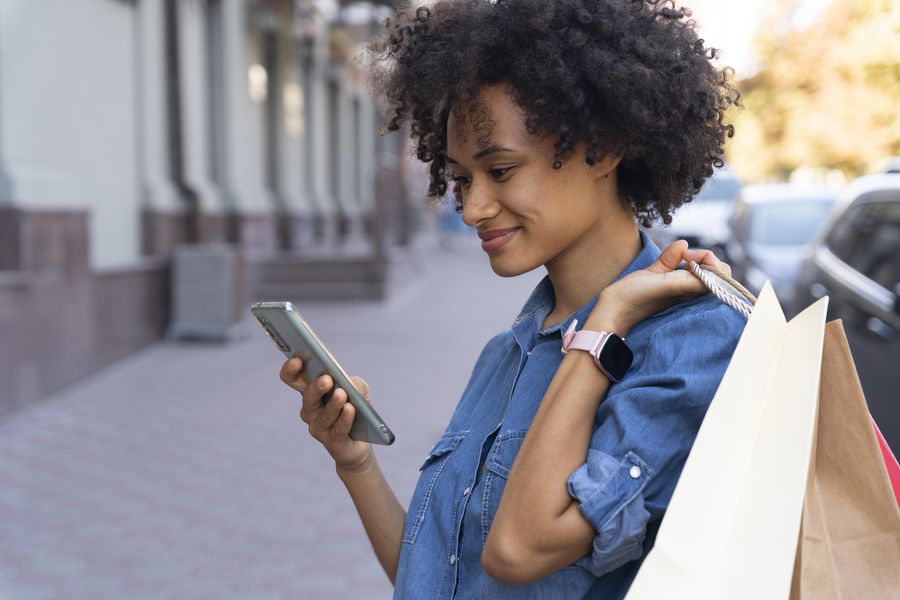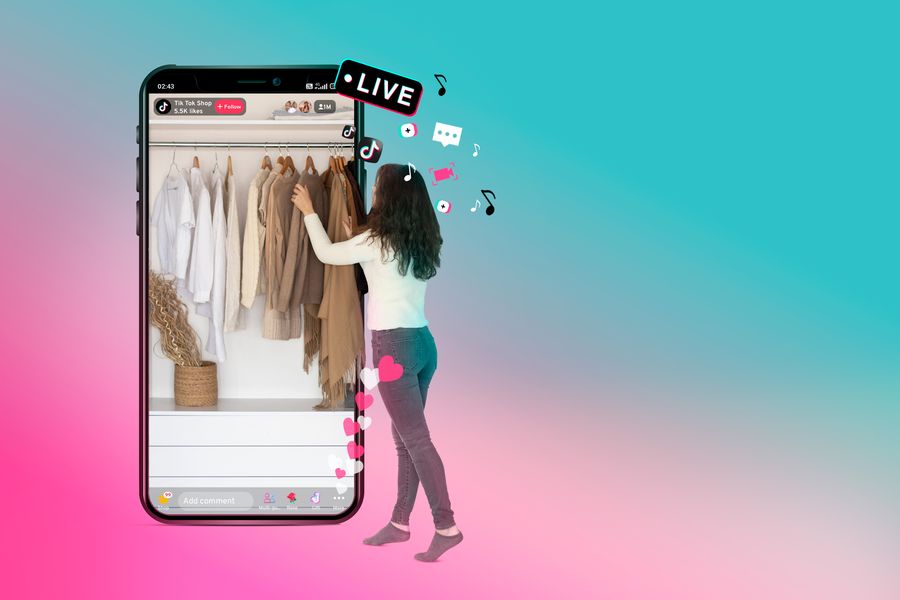M-commerce, or mobile commerce, is all the online transactions that are made through a Smartphone. In 2021, M-commerce represented 72.9% of eCommerce sales1 around the world.
For an eCommerce business, this requires making constant efforts to provide buyers with an optimal Smartphone shopping experience. Some of the things shoppers expect to find are quick and easy navigation (43%2), speedy shopping (37%2), compelling design (29%2)…
Read our 6 fundamental tips for implementing an effective M-commerce strategy.
#1. Adopt a mobile first mindset
Shoppers are more impatient and more demanding on their Smartphones than on a computer with 53% of them3 abandoning a mobile web page if it takes more than 3 seconds to load.
Businesses must adopt a mobile first approach and design their eCommerce site with the specifics of this selling channel in mind. Some elements requiring particular attention are the information architecture, web page loading times, text readability… You should also optimize the product search process and provide shoppers with advance search features such as an internal search engine, auto-completion features, faceted search options…
With 57% of shoppers3 saying they would not recommend a brand if its website was not mobile friendly, these design efforts have become unavoidable.
#2. Provide a truly omnichannel journey
Shoppers buy through their Smartphones wherever they happen to be: at home, in public transport, instore… 50.9% of shoppers4 buy through their phone at least once a week.

To help them buy at any time and from anywhere, you should make the most of new technologies: QR codes, Augmented Reality (AR), « geofencing6 »… to create true synergy between physical and digital selling channels. You should also support shoppers through their purchase and enable them to interact with the company at all times: customer service text messages, mobile app, chatbot, dedicated messaging applications…
You have to make these efforts as 75% of shoppers6 expect brands to provide a consistent shopping experience across all selling channels.
#3. Optimize the online payment process
When a shopper buys through their Smartphone, they expect the online payment process to be quick, easy, and efficient.
To achieve this, you should offer « one click payment7 » and save the shopper from having to enter their bank details for each transaction. You can also use various different strategies to simplify the completion of fields in the payment form: guest checkout, quick and secure payment methods, possibility to scan a bank card8…
Optimizing the payment process is vital because if it is too long and/or complicated 17% of shoppers9 will abandon their carts.
#4. Provide a mobile app.
85% of shoppers9 claim to prefer buying through mobile apps than through mobile websites.
Mobile apps give shoppers a more uniform and seamless shopping experience: they work 6 times faster10 than mobile websites. They also create a stronger link10 between the shopper and the brand (push notifications, text messages…).
In today's market it is essential to provide a mobile application to remain competitive. Retailers generate 2.2 times more revenue10 on this selling channel than on mobile web sites.
#5. Get the most out of social networks
Today's shoppers are hyper connected and can use their Smartphone at any time to buy through social network platforms. 29% of shoppers9 say they buy through their phone once a week. Among the platforms used are Pinterest (47%9 ) and Facebook (15%9 ).
To adapt to these new uses, businesses should make the most of the features provided by social networks: stories, IGTV, Reels… and regularly create posts and ads11 through which shoppers can buy directly.

Brands using these platforms to the full have seen their online traffic rise by 1000%10 and their revenue rise by 20%10.
#6. Reassure shoppers
When shoppers buy through their Smartphones, the lack of security can hold them back. 30% of shoppers12 are put off from buying through this channel if they have doubts about the security of mobile payment services.
To reassure their shoppers, a business should optimize the customer identification process by using two factor authentication (2FA), multi-factor authentication (MFA), and/or biometrics. They should also highlight any elements that provide reassurance (certifications, quality labels, logos showing available payment methods…) to allow shoppers to finalize their purchase serenely.
To sum up, there is a rise in the number of businesses adopting an M-commerce strategy and adapting their eCommerce sites to the new uses of shoppers on their Smartphones: shopping through social networks, preference for mobile apps, high expectations in terms of navigation… It is essential to make efforts in these areas to meet new demands and to provide a unique experience at each stage of the shopping journey, whatever the preferred shopping channel.
1
Coppola, D. (2022, May 4). Global mobile retail commerce sales share 2016-2021. Statista.
2
Ramstein, C. (2021, February 26). Quelle place pour le mobile dans sa stratégie e-commerce en 2021 ? kaliop.com.
3
Sansonetti, J. M-commerce : Définition, avantages, fonctionnement et tendances dans le monde. wizishop.fr
4
The Future of Mobile Shopping and How to Optimize Your Site. (2022, October 20). Shopify Plus.
5
Lin, Y. (2023, January 1). 10 Mobile Usage Statistics You Should Know in 2023 [Infographic]. oberlo.com.
6
Sancelot, I. (2023, March 24). Qu'est-ce que le geofencing et quel est l'intérêt ? hubspot.fr.
7
Lefèvre, F. (2021, April 23). L'importance du mobile dans votre stratégie omnicanal. kaliop.com.
8
Bathelot, B. (2011, November 23). One click shopping - Définitions Marketing » . definitions-marketing.com.
9
Contentsquare. Ecommerce mobile : l'expérience de navigation avant la conversion. contentSquare.com.
10
Wertz, J. (2022, May 9). 3 Mobile Commerce Trends That Are Dominating 2022. Forbes.
11
Holly, S. (2023, May 31). Instagram Ecommerce : Strategies & Examples (2023). Shopify Plus.
12
Breaking Down M-Commerce : Statistics, Trends and What to Expect as Ecommerce Goes Mobile. BigCommerce.







